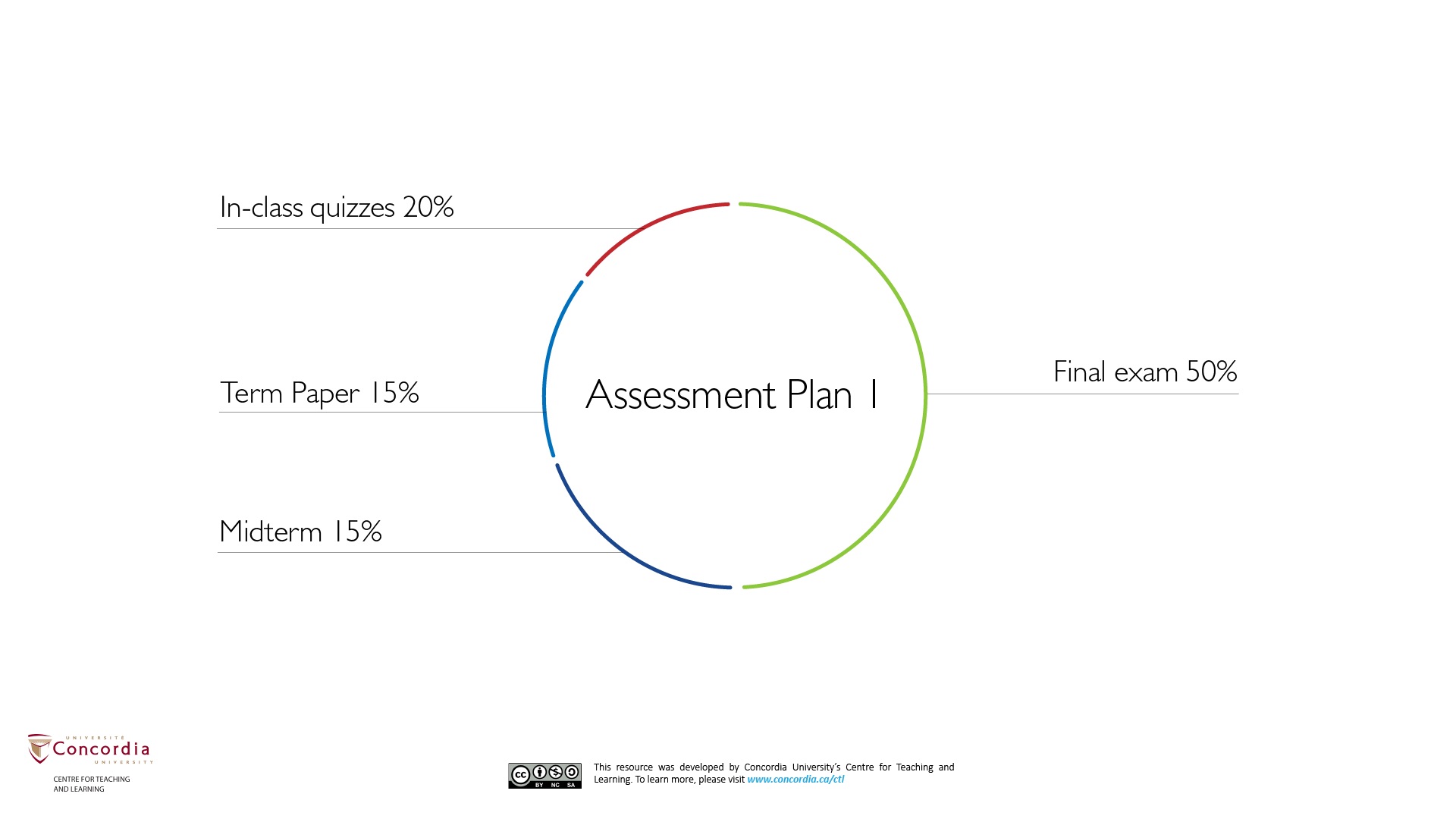Develop a balanced assessment plan
In brief
- As you finalize each of your assessments for your course, you will need to consider them as a whole and determine if your strategy is balanced in relation to your learning outcomes and diverse in the methods you use.
- The weight of each assessment should be related to the effort of work required and the portion of the learning outcomes being assessed.
- The timing of assessments is influenced by many factors including the effort, pacing of the content and opportunities for feedback.
On this page
Develop your assessment plan
An assessment plan is the list of the assignments, projects, quizzes, and exams, their descriptions, and the respective weightings and due dates for a specific course. This plan is required in all course syllabi. Therefore, your assessment plan should include all of these elements.
Your assessment plan should look something like the examples below. You should have a number of assessments with their weightings that sum up to 100%.
Each assignment, test or exam should directly target one or more of your learning outcomes.
When all your assessments measure specific learning outcomes and all of the learning outcomes are evaluated, you have achieved alignment.
Assessment plan examples
These two example assessment plans below take somewhat different approaches to evaluating student learning. The sections below summarize the pros and cons of each.
Assessment plan example #1

Pros
- Exams, especially multiple choice, are quicker to grade.
Cons
- High-stakes assessments (exams and quizzes) privilege students who are used to high-stakes exams and perform well under pressure.
- High proportion of assessment is for midterm and final exams, which centers students’ work around “passing the exam” and promotes a surface approach to learning and cramming.
- Fewer opportunities to provide feedback from this type of assessment throughout the term.
Assessment plan example #2

Pros
- Diversity of assessment types gives students the opportunity to demonstrate their learning using multiple means and is more inclusive.
- Frequent, low stakes tasks (responses) encourage students to engage with the content regularly and receive feedback on their learning throughout the term.
- A scaffolded term paper provides the opportunity for students to receive feedback from the Instructor on discrete areas of learning and throughout the process of a major assignment.
Cons
- Grading and feedback is more time-consuming.
The diverse pros and cons in these examples demonstrate how assessment drives the different ways students approach learning for a course. As you develop your own plan, consider how you might be able to design assessments to promote learning and provide feedback throughout the term.
Weighting of assessments
The weighting of an assessment refers to the proportion of marks allocated to a particular assessment item. For example, an exam might be graded out of 100, but is weighted at 25% of the total grade.
The weighting of an assessment item should reflect:
- The relative importance of that assessment item in relation to the whole assessment plan
- The relative amount of time students will spend on the task. For example, a five-page paper with references should not be weighted the same as a reading summary or reflection.
- Assessment tasks for supporting learning outcomes should carry a lower weighting, whereas assessment for more complex and important learning outcomes should have a higher weighting.
Timing of assessments
Timing refers to when an assessment will be given or due for submission. It is critical that you time your assessment strategically to make sure that 1) the material to be assessed has been learned and students have enough time to prepare; 2) there is adequate time for you provide feedback and students to act on it for future improvement.
As you plan the timing of assignments, consider the following points:
- Students need sufficient time to complete assignments. For example, it would not be appropriate for an assessment worth 40% to be due very early in the term, before that proportion of the course had been taught.
- Early, low stakes assessments are recommended to give students prompt feedback on their performance and to identify those who might be at risk of not succeeding in the course. This also helps maintain students’ confidence level and motivates them to work harder for the rest of the term. If their first assessment is a high-stakes mid-term in which they do poorly, they may lose their motivation to continue, believing it is too late in the semester to ‘catch up’.
- Give sufficient space between each assignment so that students have the opportunity to incorporate feedback from the previous assignment to the following assignment.
- Plan for timely feedback to students. Check your own calendar to make sure you will have time to return the assignments within a reasonable timeframe, particularly if you are teaching several classes. You may want to consider blocking some time in your calendar in advance for grading.
- Avoid scheduling due dates that fall on any religious holidays. Consult the Days of significance calendar and Interfaith calendar for a complete list of religious holidays.
- Keep in mind that the end of the term is a very busy time for all students. They are often working on assignments for multiple classes at the same time while also preparing for exams.
- Each term, find out when the drop date is for students to withdraw without academic penalty (DISC) from a course (c.f., Concordia academic calendar). By having one or two assessments before this date, students will know if they are at risk of failing the course.
Resources
- Concordia University. (n.d.). Academic calendar dates. https://www.concordia.ca/academics/graduate/calendar/current/academic-calendar/current-academic-calendar-dates.html
- Concordia University. (n.d.). Days of significance. https://www.concordia.ca/events/days-of-significance.html
- Interfaith calendar. (2018, January 12). https://www.interfaith-calendar.org
References
- Carnegie Mellon University Eberly Center. (n.d.). Creating assignments. https://www.cmu.edu/teaching/assessment/assesslearning/creatingassignments.html

